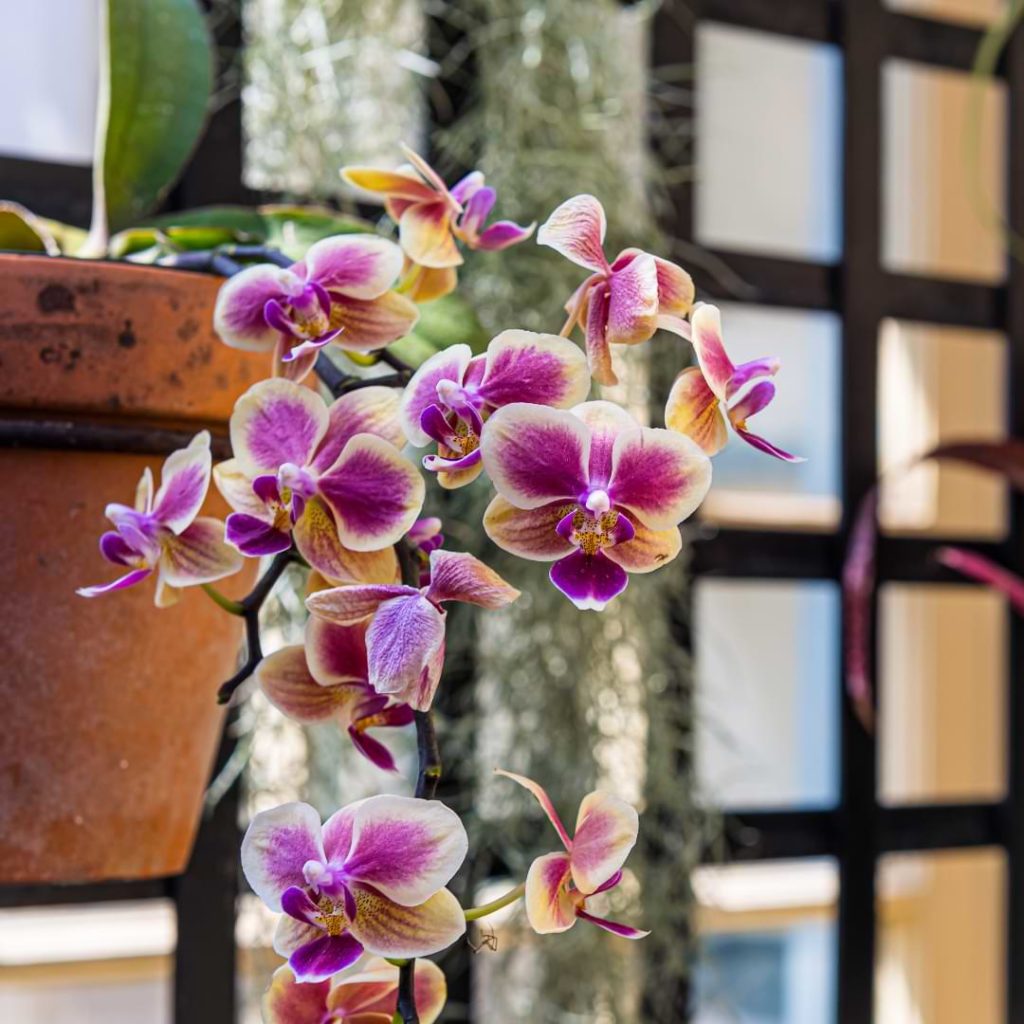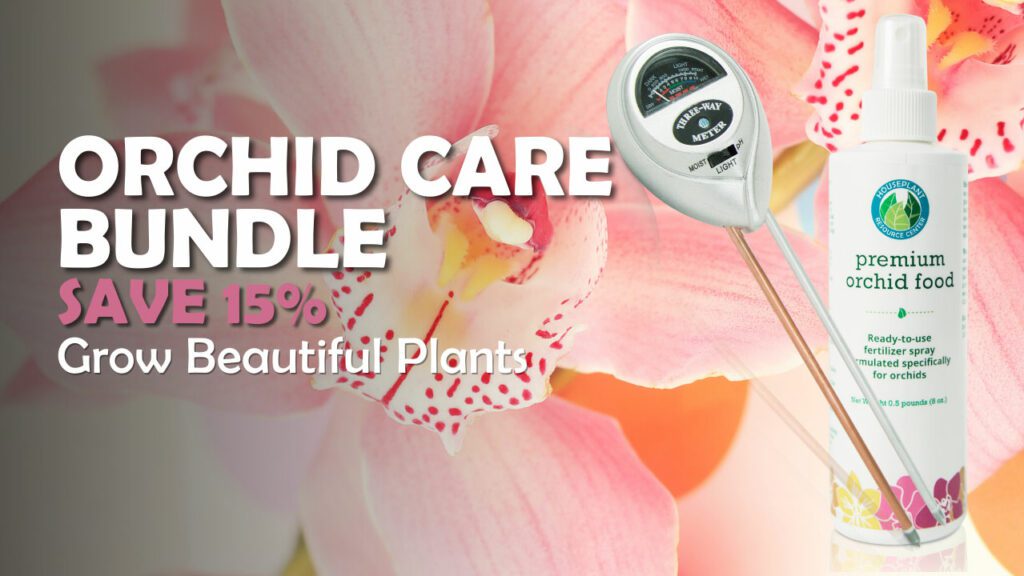Unlike most houseplants, growing orchids in a pot isn’t your only option. Instead, you can grow hanging orchids that take up less space and add beautiful vertical interest to your space. Hanging orchids are a wonderful addition to an indoor or outdoor space.
What Are Hanging Orchids?
Hanging orchids are orchids that are grown in hanging baskets or mounted to a surface. You can sometimes even grow hanging orchids outdoors on trees if you live in the right climate.
Many orchids are epiphytic plants. These kinds of plants do not have to be attached to the ground in order to grow. Instead, they grow on another plant or other physical support. In their natural environment, around 70 percent of orchids grow on trees or rock formations. Epiphytic plants aren’t parasitic. They absorb the water and nutrients they need from the rain, air, and other nearby sources.
For this reason, many orchids don’t need to be grown in a pot filled with soil. If you are able to provide the right conditions, you can grow hanging orchids with their roots exposed instead.
9 Beautiful Hanging Orchids
Not all orchids will grow as hanging orchids. Here are a few orchids commonly used as hanging orchids although many of these will also grow in a container with growing medium too.
Angraecum
Orchids in this genus typically do well as hanging orchids even though they can be grown in soil as well. Characteristics of Angraecum orchids vary widely, but all are monopodial, meaning that they have a single stem. They are also pollinated by moths, so most of these orchids are white and produce fragrance at night to attract their pollinators.
Angraecum orchids have different care guidelines depending on their species because different species are native to a variety of habits. In general, Angraecum orchids prefer a medium amount of light and do best when the daytime temperatures are around 70 degrees Fahrenheit, dropping 10 to 15 degrees at night. They need humidity levels between 50 and 70 percent.
Brassavola
Orchids in this genus are considered easy to grow and are frequently grown as mounted orchids. If you’re new to hanging orchids, Brassavola is the perfect place to start. Brassavola usually has large white blooms with a white lip and gives off a citrus fragrance at night. The most well-known species is Brassavola nodosa, which is commonly called the Lady of the Night Orchid.
Brassavola is one of the easier orchids to care for, but they do have specific needs. Brassavola does best in medium to high light. They prefer temperatures in the 70-to-80-degree Fahrenheit range during the day with a drop between 10 to 15 degrees during the night. Brassavola can handle humidity levels as low as 40 percent, but they really respond better in environments with 50 to 70 percent humidity. Allow Brassavola to dry out between waterings. However, during warmer months, expect to water them on a near-daily basis.
Cattleya
A popular orchid, Cattleya is closely related to Brassavola. Like Brassavola, Cattleya is relatively easy to care for. Many Cattleyas are able to bloom two to three times per year, and some have a pleasant fragrance. This type of orchid is sympodial (growing from multiple stems) and produces pseudobulbs (pod-like structures that grow directly below the leaves) from a rhizome (a horizontal stem, always growing out laterally instead of upward). These orchids also have thick leaves that help keep in moisture.
To care for cattleyas, give them access to high amounts of light. Some cattleyas can even handle direct light. Cattleyas prefer to dry out between waterings, which means you may be able to skip a day or two between waterings if you grow them as hanging orchids. Cattleya orchids prefer temperatures between 70-80 degrees Fahrenheit during the day with a 10-to-15-degree drop at night. However, some cattleyas prefer higher temperatures. They do well with humidity between 50-60 percent.
Cymbidium
These showy orchids are also referred to as boat orchids. Cymbidium orchids produce large colorful flowers. Different types of these orchids produce different-colored flowers in almost every color you can imagine. Cymbidiums are sympodial orchids with dense pseudobulbs. Their leaves are typically narrow and some have beautifully variegated leaves.
Cymbidiums are a good choice for hanging orchids because they do not like their roots to be disturbed. If grown in soil, you have to be very careful when repotting, but when mounted, they can happily grow without too much disturbance.
Cymbidiums are a bit more temperamental about their care. They do best with bright indirect lighting. As far as temperature goes, cymbidiums require cool temperatures to start blooming. In the fall, they need temperatures ranging from 55 down to 30 degrees Fahrenheit to initiate blooms. The rest of the time, they prefer day temperatures between 65-75 degrees Fahrenheit with a drop of 10-15 degrees at night.
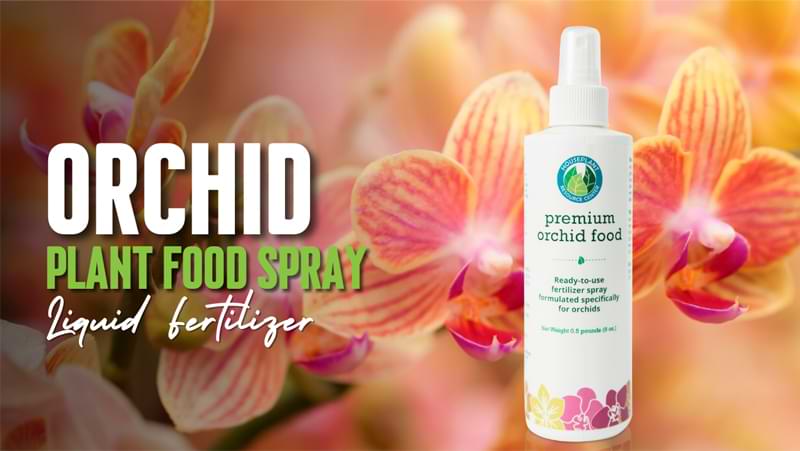
Dendrobium
With over 1,200 species, Dendrobium is a very diverse genus of orchids. Their physical characteristics vary, but typically Dendrobium orchids have a large number of blooms. They are also usually epiphytes, making them a good choice for hanging orchids.
Dendrobiums have a reputation for being easy to care for, but it really does depend on which species of Dendrobium you have. In general, expect Dendrobiums to need bright light, intermediate temperature requirements, and drying out between waterings. However, it’s best to find out which species you have to ensure you take care of your Dendrobium orchid properly.
Oncidium
Another group of very diverse orchids, Oncidiums are commonly called Dancing Lady Orchids due to the appearance of their ruffled flowers. Most Oncidiums are epiphytes, so they generally do well as hanging orchids. However, there are some Oncidiums that are terrestrial so it’s important to know which species you have.
Oncidium orchids have a wide variety of native habits, so orchids in this category can have very different needs. In general, most prefer daytime temperatures between 60-75 degrees Fahrenheit with a drop of 10-15 degrees at night. One tricky aspect of caring for this orchid is that Oncidium usually needs humidity of around 70 percent. Therefore, growing them indoors is difficult. They do not like to dry out between waterings, so they need to be watered frequently, especially when grown as hanging orchids.
Phalaenopsis
Phalaenopsis (commonly called moth orchids or “phals”) are one of the most common household orchids and a great choice for beginners. These plants grow as epiphytes in the wild, meaning that they’re a great option as hanging orchids, but they’ll also happily grow in containers with soil as well.
Phals prefer relatively low lighting and should not be placed in direct sunlight. They like temperatures between 70-85 degrees Fahrenheit during the daytime with a drop of around 10-15 degrees at night. While they prefer humidity around 70 percent, they can handle lower levels just fine, but they don’t like to dry out too much between waterings. These lovely orchids are a great choice to try as an introduction to the world of hanging orchids.
Tolumnia
Tolumnia orchids are usually petite compared to other orchids, and they are relatively good at adapting to a range of growing conditions. Mounting is usually a good choice for these orchids because their roots need adequate access to air in addition to needing to dry quickly after watering.
These orchids prefer medium levels of light. They grow well when the temperature is between 55-90 degrees Fahrenheit, and their preference for humidity ranges from 50-70 percent. Mounted Tolumias should be watered on a daily basis, but they should not be watered during the heat of the day.
Vanda
Vanda orchids typically have large showy flowers that make them a focal point in any environment.
Orchids in this group prefer high levels of light and like warm daytime temperatures between 70-95 degrees Fahrenheit with a 10-to-15-degree drop at night. They like humidity of 70 percent but can handle conditions as low as 50 percent. Water often because they are not able to store water. Vandas need good air circulation around their roots, which means that growing them as hanging orchids is typically better than in a traditional growing medium.
How to Care for Hanging Orchids
As you saw above, the care for hanging orchids depends partly on which type of orchid you have. However, there are a few general rules that apply to all hanging orchids.

Take Extra Care With Freshly Hung Orchid Roots
Roots on orchids that have previously been placed in containers with a growing medium may take some time to adapt to their new environment. Many people gently wrap sphagnum moss around newly exposed orchid roots to help retain water for the roots until they are used to the change.
You’ll also generally need to carefully wrap material like strips of pantyhose or string around the orchid to keep it in place while its roots take time to attach to a mount or other object. Be careful not to damage the roots during this process.
Position
The best position for hanging orchids depends on the type of orchid. The first thing to consider is how much light your orchid needs. This will be the largest factor in determining where to place your hanging orchid. Other needs like temperature and humidity will also play a role. However, most orchids commonly grown as hanging orchids can handle the temperature in the average home.
Watering and Misting Hanging Orchids
Orchids grown as hanging orchids will need to be watered more frequently than their counterparts grown in containers with a growing medium. You will usually have to water daily or at least every other day or two.
When watering, it’s best to either turn on a faucet and run water over the orchid’s roots or dunk the roots in a container of water for a short period. The good news is that it’s very difficult to overwater hanging orchids.
If you’d like to mist your orchids in addition to watering them, you can. Misting can raise the humidity around the orchid slightly, but it doesn’t have a long-term effect. Since you’ll already be watering hanging orchids fairly frequently, you won’t see much benefit from misting every day. Misting doesn’t hurt your orchids, though, so if you want to give your orchids a little misting, then go ahead.
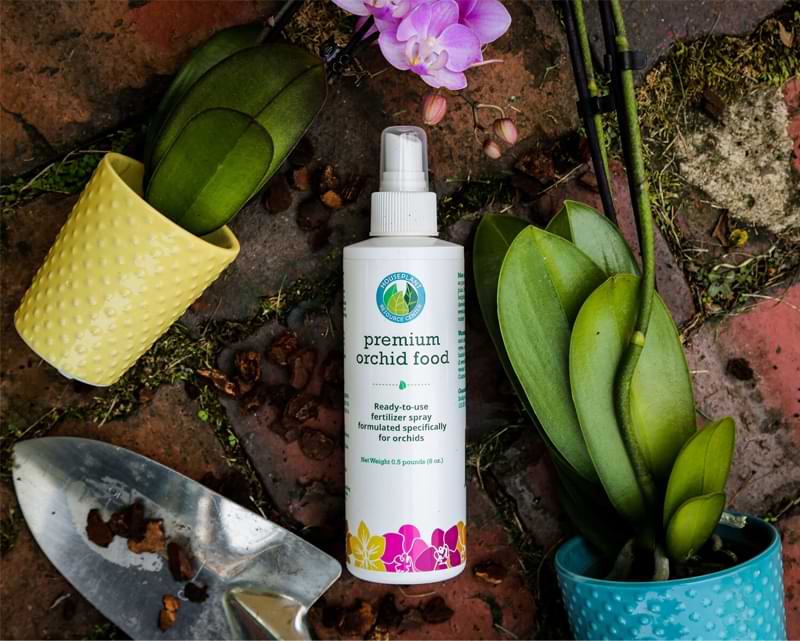
Feeding Orchids
Orchids need a light amount of fertilizer in order to thrive. Typically, we advise fertilizing every time you water orchids grown in containers, but hanging orchids don’t necessarily need to be fertilized each time you water.
Use a gentle, diluted fertilizer about once a week when watering. You may need to fertilize less often during periods when your orchid is not actively growing. Orchids do well with a balanced fertilizer, one where the NPK levels (nitrogen, phosphorus, and potassium) are equal.
Ideas for Hanging Your Orchids
There are many different ways to display hanging orchids. No matter how you decide to display them, they’ll definitely be an attractive addition to any area. Here are some of the most common ways to display hanging orchids.
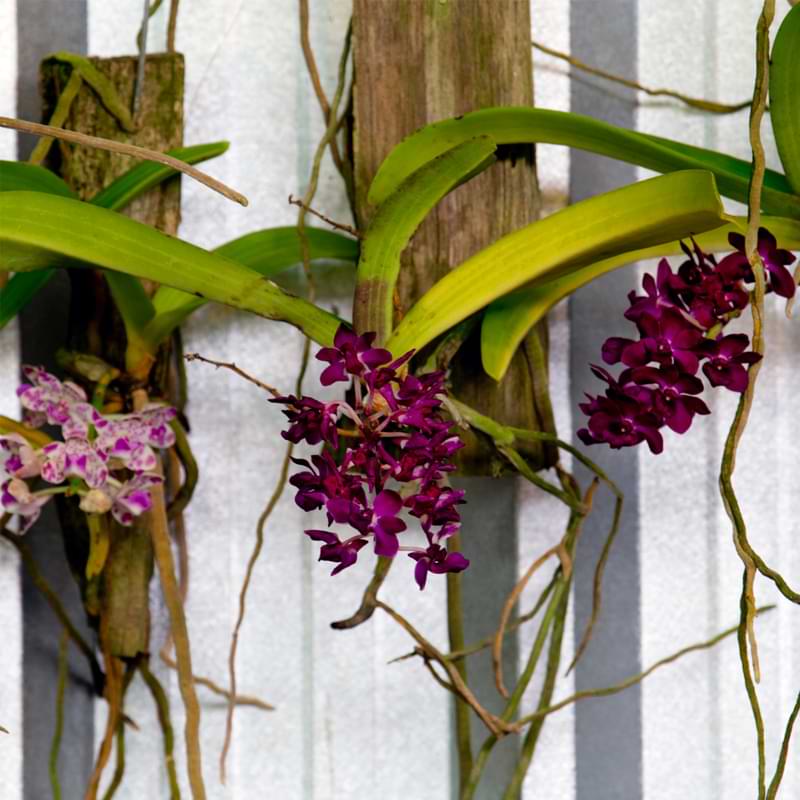
Wall-Mounted Orchids
Wall-mounted orchids are popular, and there are a variety of materials available to use as mounts. The most common material for mounts is cork, but you can also use wood mounts, tree fern mounts, or even driftwood.
Related Reading: Mounting Orchids | Driftwood, Rock, and More…
Suspended From the Ceiling
Mounted orchids can also look lovely when suspended from the ceiling. As long as you have a way to hook your mount to the ceiling, you can use almost any material as a mount. One benefit of displaying orchids this way is that you have more options of where to place your orchid to get the right amount of light. Just remember that you will need to be able to unhook the mount to bring it to the sink for water fairly frequently.
Hanging Orchids on Trees
Epiphytic orchids usually grow on trees or other objects in their natural environment. If you live in a climate that mimics your orchid’s natural environment, you may be able to allow your orchid to grow outdoors on a tree. You can carefully attach your orchid to a tree trunk or in the space where a branch meets the trunk using nylon or other string, and the orchid’s roots will eventually attach to the tree. If your climate allows you to grow orchids this way, we highly recommend trying it.
Growing Orchids in Hanging Baskets
Hanging baskets for orchids are typically wooden with slats that allow airflow. Most people line the baskets with either sphagnum moss or coco coir to help retain water. Besides looking attractive, hanging baskets allow you to have more control over where you place your orchid.
Hanging Orchids FAQ
How do you get an orchid to bloom again?
Different orchids have different requirements for blooming. Find out what conditions the type of orchid you have requires for blooming. Some orchids will only bloom once a year while other types will bloom multiple times a year.
Can you water orchids with tap water?
As long as your tap water doesn’t contain an excessive amount of chemicals, tap water is safe for orchids. If there is an issue with your tap water, use rainwater or buy distilled water instead.
Final Thoughts: Hanging Orchids
Hanging orchids is a beautiful way to display this beloved plant. While you do have to water these orchids more frequently, many epiphytic orchids thrive due to improved air circulation around their roots.
If you’ve been wanting to give hanging orchids a try and you’re prepared to give them the attention they need, then go ahead—chances are you’ll love the results.
Join Our Orchid Care Facebook Community
In our Facebook group of orchid lovers, we’re dedicated to creating a rich and engaging environment where plant lovers can come together and share tips, tricks, and experiences.
If you’re an orchid lover, come join our Facebook community! We can’t wait to celebrate your successes and help you troubleshoot your care routine.
For continued success, you can explore our other articles or visit our online shop for plant care products that are sure to keep your plants boasting rich green leaves and big, bountiful blooms year-round.
More Great Orchid Resources

